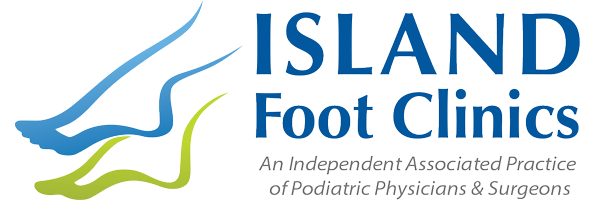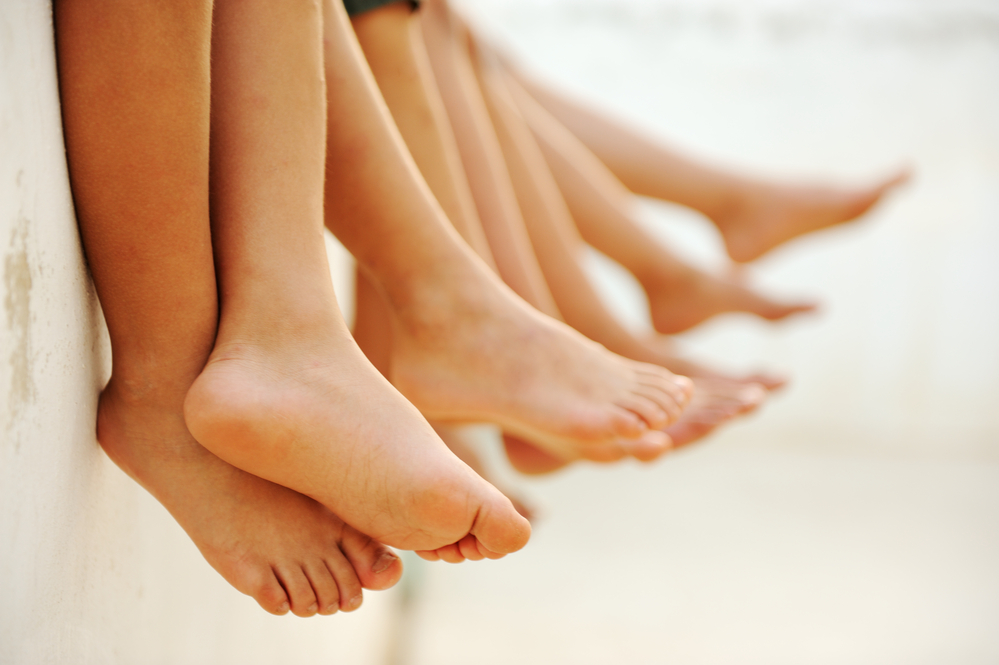If your child complains of foot pain, it can be difficult to know how serious it really is. You might try to treat the problem at home and hope the issue resolves itself. If it doesn’t, you may try a visit to the pediatrician, who doesn’t specialize in foot conditions and may not be able to provide the necessary treatment. A better option would be to consult a children’s foot doctor, such as the expert podiatrists at Island Foot Clinics located throughout British Columbia.
Podiatrists are doctors who specialize in issues of the feet and lower legs for both children and adults. They perform physical examinations and use state-of-the-art diagnostic tools–including gait analysis, x-rays, bone scans, CT, MRI, and other imaging studies–to diagnose issues and provide proper treatment.
Common Causes of Foot and Ankle Pain
If your child is limping, tends to trip more than other kids, has feet that point inward, has flat arches, or has toes that don’t line up correctly, this could be an indication of a more serious problem, even if he or she isn’t complaining of pain. A children’s foot doctor can diagnose the issue and may recommend exercises, custom orthotics, or braces or perform surgery to alleviate the problem.
Flat Feet
Flat arches are common in infants and toddlers. Children usually start developing a longitudinal arch once they are standing and walking. By adulthood, most have fully developed normal arches. Those who don’t are considered to have flat feet.
Having flat feet isn’t necessarily a problem. Many patients experience no pain or issues with the condition. However, flat feet can cause severe discomfort, with pain in the arches, ankles, knees, legs, and back. In addition, people with flat feet may experience excessive pronation, which means their ankle rolls too far downward and inward when they walk or run. This affects balance and places abnormal stress on these areas, which can lead to injury.
Children who are experiencing pain or discomfort in the foot, ankle, or lower leg should have their feet evaluated by a children’s foot doctor. Shoe modification and orthotics can permanently increase the arch height and significantly improve the structure of the foot, especially if started early enough. Surgical repair is usually only indicated for severe cases or for cases that don’t respond to orthotics after an extended time.
In-Toed and Out-Toed Gait
Your child may have bowlegs or knock knees or feet that point inward or outward when walking or running. This is common and usually not painful. Most children outgrow the problem without intervention. However, if you’re concerned about the severity of the issue, it’s causing pain or limping, or if it continues into school age, a foot doctor can make an evaluation and determine if corrective procedures are indicated.
Crossover and Hammer Toes
Crossover or curly toes is an inherited condition that typically affects the third or fourth toes and is one of the most common toe problems in children. A hammertoe bends at the middle joint and usually affects the second toe. Both conditions can be quite painful, especially when the affected toes rub against the child’s shoes.
When caught early, toe issues are often treatable with shoe inserts, pads, taping, roomier shoes, and stretching exercises. If the problem persists after the bones have completely matured, corrective surgery may be necessary.
Bunions
Hallux valgus, more commonly known as bunions, is a common inherited deformity of the big toe. It’s most often seen in girls during adolescence. Even if the bunion isn’t painful, it’s important to have the issue treated to delay the progression of the deformity. Proper shoe choice and custom orthotics can help decrease the stress on the toe. If the bunion is painful and persists into adolescence, once the bones have completely matured, surgical repair may be indicated.
Growth Plate Injuries
If your child is limping and complaining of pain, the cause may be a growth plate injury. Growth plates are located at the end of the body’s long bones, such as the thigh bone (femur) and the lower leg bones (tibia and fibula). Symptoms of injury are pain and swelling at the end of the bone, difficulty moving the bone, and the bone appearing out of alignment or crooked.
Heel pain
Sever’s disease, also known as calcaneal apophysitis, is a common growth plate injury and the most likely cause of heel pain in children. Injury is often caused by overuse in sports activities, especially running, jumping, and pounding on hard surfaces.
Non-athletes can also suffer from Sever’s disease, due to uneven growth spurts, tight tendons and muscles, and trauma to the bone. Poor footwear can also be a contributing factor. It’s important to have your children’s podiatrist examine the injury within the first few days of occurrence, in order to avoid complications during the healing process.
There are many other possible causes of heel pain, including tendonitis, heel spurs, bursitis, stress fractures, bone tumor, infection, and nerve inflammation. Your podiatrist can make the appropriate diagnosis and prescribe proper treatment.
Other Injuries
Your children’s foot doctor can diagnose and treat other common injuries of the foot and ankle, such as sprains, strains, fractures, and Achilles tendinitis. The doctor may also offer recommendations on how to avoid future injury, especially if your child participates in athletics.
Painful Skin Conditions
Plantar warts are growths on the bottom of the foot. Children get them by walking barefoot at swimming pools, the beach, or anywhere that the HPV virus can be found. They may be difficult to treat at home and may require a visit to the children’s foot doctor if painful or bleeding. They’re also contagious and can spread to other members of the household if not properly treated.
Athlete’s Foot, or tinea pedis, is a common skin issue in children, often the result of wearing sweaty shoes and socks. Caused by a fungal infection, the first symptom is often itchiness and a rash between the toes, which can escalate to painful and severe cracks in the skin. It can usually be treated at home with antifungal medications and keeping the feet dry. If the problem is chronic, severe, or causes a secondary infection, you should plan a visit to your podiatrist.
Toenail Issues
Ingrown toenails are common in teenagers, but even babies have been known to get ingrown toenails. In adolescents, the issue is often from neglect or cutting their toenails incorrectly. They can also pick at their toenails and cause the problem. Shoes can also be an issue, especially sports cleats. Ingrown toenails can not only be painful, but they can also get infected if not properly treated by your podiatrist.
Children and Diabetic Foot Care
Though it isn’t common for children to develop foot problems due to their diabetes, it’s recommended that those with type 1 or type 2 diabetes get annual foot exams starting at puberty. It’s important for young patients to be educated in the proper care of their feet and to get any foot issues treated before they become serious.
Proper Foot Care
The podiatrist can advise young patients and their caregivers about diabetes-related foot care, such as:
- Appropriate footwear
- Proper monitoring of feet
- Nail and skincare
- Wound care
- How diet and insulin control affect foot health
Diabetes-Related Foot Issues
The podiatrist can treat diabetes-related foot issues, such as:
- Foot pain, burning, numbness or tingling
- Nail problems such as ingrown toenails
- Foot ulcers, wounds, and sores
- Foot lesions that are infected or not properly healing
Seek Help from a Children’s Foot Doctor
If your child is experiencing foot or ankle issues, our caring and expert team of podiatrists at Island Foot Clinics is here to help. Call to schedule an appointment at Island Foot Clinics today. We have conveniently located clinics throughout British Columbia to serve you in Kelowna, Nanaimo, Victoria, Campbell River, Prince George, Terrace, Williams Lake, Salmon Arm, Kamloops, Osoyoos, Penticton.

